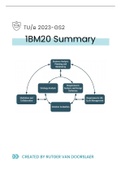Samenvatting
1BM20 - Summary ()
- Instelling
- Technische Universiteit Eindhoven (TUE)
A summary of all video lectures and in-class discussions of the course 1BM20 - Business analysis for information technology systems given for the master track Innovation Management for Industrial Engineering / Technische Bedrijfskunde at the Eindhoven University of Technology.
[Meer zien]




